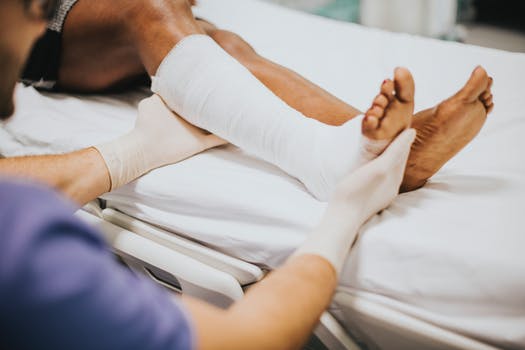
Even with all the safety technologies available, about 13 car crashes still occur in the U.S. every minute. They cost the economy hundreds of millions, a whopping $474 billion in 2020 alone! Even worse, they’re behind millions of people sustaining severe injuries.
Some of the most common and worst are leg injuries, including deep wounds and broken bones. An auto accident can also aggravate pre-existing lower limb injuries or medical conditions.
But there’s still some good news. Victims may seek compensation for leg injuries from car accidents.
So if you’ve been in a crash and injured your leg, it’s best to learn how to get legal compensation. We’ll tell you what you need to know in this comprehensive guide, so keep reading.
Seek Professional Medical Help
Not all leg injuries are visible; they can be internal, taking days or weeks to exhibit symptoms.
An example is a torn knee ligament, which may mimic the signs of a sprain. It usually causes knee and leg pain, but you may only feel it a day or two after the crash. However, because it feels like a sprain, you may wrongly believe it will improve soon.
Unfortunately, torn ligaments can be so severe they may cause intense pain. While pain relievers may help, their effects are only temporary. You might end up requiring physical therapy or even reconstruction surgery.
Another example is a puncture wound that seems minor but, in reality, is worse than it looks. However, because it doesn’t look so bad, you may think it’s okay not to seek professional help. Without proper treatment, though, it may become infected within a week or two.
Please be aware that infected wounds can become chronic. Chronic wounds, in turn, affect an estimated 6.5 million people in the U.S. alone.
Chronic or infected wounds can also cause nerve damage or gangrene. It may even result in a loss of function in the affected site. Some of the most severe cases could even lead to amputation.
For those reasons, please don’t delay seeing a doctor as soon as you can following a car crash. Besides being for your safety, you also need their records when you file an insurance or legal claim.
File an Insurance Claim
It depends on your state, but you may have to file a claim with your insurance provider. This applies to 12 states with no-fault insurance laws, such as Florida, Kansas, and New York, to name a few.
No-fault insurance is the other term for personal injury protection (PIP) coverage.
People involved in a crash in a no-fault state don’t have to prove negligence to file a claim. Instead, they can file a medical claim with their insurance company. Their insurer then pays their medical bills up to their policy’s limits.
Aside from medical bills, auto insurers in no-fault states may also pay for lost wages. This kicks in if you or your passengers can’t work due to personal injuries caused by the crash.
PIP also often covers disability and rehabilitation costs. For example, if you must get physical therapy for months to get back on your feet.
In some no-fault states, PIP coverage may include the cost of household services. The need for these must be directly due to the injury. For example, if you have to pay for childcare as your leg injury prevents you from looking after your child.
File a Third-Party Insurance Claim
In no-fault states, PIP isn’t mandatory. Instead, insurers offer an optional alternative called medical payments coverage (MPC). It’s similar to PIP in that it covers the hospital bills of the insured without the need to prove who’s at fault.
Since MPC isn’t mandatory, not everyone opts for it. If you haven’t, you can file for a third-party insurance claim. This involves contacting the other driver’s insurance company for compensation.
You must prove the driver whose policy you’re filing a claim against was at fault for your injuries. To do this, you must provide proof, such as the following:
- Photos and videos of the accident scene (including the vehicles)
- Police report
- Witness statements
- Your official medical and doctor’s records
You must also fill out a claims form issued by the at-fault driver’s insurer. You can complete this online on that insurance company’s website. You can also call them for further instructions.
Prepare to give the other driver’s name, contact details, and auto insurance information. You may also need to share their vehicle, license, and registration information.
After that, the insurer investigates your claim. They’ll call you to make a settlement offer if they determine their policyholder was at fault. Before accepting their offer, consider consulting a personal injury attorney or law firm.
Consult a Personal Injury Lawyer
A personal injury attorney can help you determine your claim’s worth. They can then advise you whether the offer of the at-fault party’s insurer is fair or not.
You don’t have to pay most personal injury lawyers for an initial consultation. According to the Aramjoo Law Firm, you can schedule one for free.
During the meeting, you and the legal professionals will discuss the incident. They’ll use the information you give them to gauge how much your claim is worth. They’ll also tell you if you deserve a higher amount or if you can pursue the at-fault driver for other damages.
Pursuing a higher claim amount and other damages requires a lot of legwork, though. In this case, you can hire a lawyer to handle most of it. You don’t have to pay them immediately; most only charge fees if they obtain a settlement on your behalf.
Leg Injuries From Car Accidents Warrant Compensation
Leg injuries from car accidents, especially severe ones, can cause life-long suffering. They may even rob people of their lower limbs, leaving them with a permanent disability.
That should be enough reason to get your leg injuries from a crash looked at ASAP by a doctor. Then, file an insurance claim to ensure you get adequate and fair compensation. Better yet, hire a lawyer to help you throughout the entire process.
For more legal-related guides like this, browse our editor’s picks and featured posts!





